Do Hawks Eat Eagles? Discover the Incredible Truth Today!
Hawks are small and medium-sized raptors found in the genus Accipiter. These birds are smaller than eagles but bigger than falcons.
Eagles, on the other hand, are large and powerfully-built predators found in the family Accipitridae. For years they have been used as a symbol of bravery, courage, honor, and pride. These birds are also known for their ability to see far, up to 5 kilometers (3 miles.)
Hawks and eagles eat various prey animals, like rodents, aquatic vertebrates, reptiles, and birds. Eagles’ large bodies allow them to feed on larger prey, like monkeys and sloths.
On some occasions, these birds may prey on the young ones of each other. However, this greatly depends on the species since both hawk and eagle species vary in size.
The article focuses on hawks preying on eagles, discussing occasions that can happen and contributing factors. Read on to learn more about other raptors they can eat to help answer the question, what do hawks eat?
Overview of Hawk and Eagle Species
The following table contains some common hawk and eagle species and their sizes and weights. This information can help you determine which species are likely to prey on the other, depending on size.

| Hawks | Eagles | ||||
| Hawk Species | Average Size | Average Weight | Eagles Species | Average Size | Average Weight |
| Ferruginous | 22.5 inches | 3.5 lbs. | Bald eagle | 34 inches | 10.2 lbs. |
| Red-tailed | 21.5 inches | 2.66 lbs. | Golden | 30 inches | 10.5 lbs. |
| Harris’s | 20.5 inches | 1.5 lbs. | Harpy | 38 inches | 16.5 lbs. |
| Broad-winged | 15 inches | 0.95 lbs. | White-tailed | 31.5 inches | 10.3 lbs. |
| Sharp Shinned | 12 inches | 5.3 Oz. | Black kite | 21 inches | 2.0 lbs. |
| Cooper’s | 17 inches | 1.3 lbs. | Crowned eagle | 35 inches | 8.0 lbs. |
Occurrence of Hawks Preying on Eagles
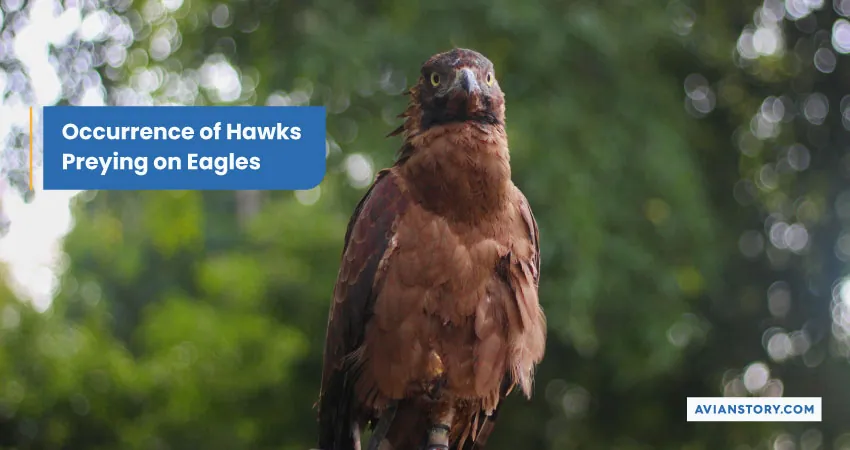
It’s rare for a hawk to prey on and eat an adult eagle. However, they can prey on the nest for their eggs before they hatch. With the hawks’ sizes being almost half of the eagles’, it’s hard for them to prey on these bigger and faster prey.
One of the common questions people ask when exploring the hawks’ diet is, do hawks eat baby eagles? While the hawks may not take down and eat an adult eagle, they can prey on and eat the eaglets.
Instances of hawks attacking eagles
These two raptors are bitter enemies known to fight each other for many years. The two common rival species are the red-tailed hawk and the bald eagle. Some of the instances a hawk attacked an eagle include the following.
1. Competition for resources
Hawks and eagles fight when they are competing for the same resources. The following video shows hawks attacking a bald eagle, probably for the prairie dog prey nearby.
2. Territorial disputes
During nesting season, territorial disputes erupt between the two species. Eagles and hawks breed in spring when most territorial fights take place. Following is a video showing a hawk attacking a bald eagle, probably for a territorial dispute.
3. Predation of juvenile eagles
Eaglets and juvenile eagles are much easier targets by hawks, especially with the parents away. The hawks are more agile hunters, which makes swooping and catching the eaglets and juveniles easier.
The following video shows a Goshawk attacking a booted eagle nest and carrying two eaglets.
Factors Influencing Hawk-Eagle Interactions

Some of the factors influencing the interactions of the two predator birds include.
Size Difference
While the hawks are often aggressive than the eagles, they are smaller. This size difference makes it hard for them to prey on adult eagles. However, the eaglets and juveniles since they are smaller.
Habitat
These birds of prey sometimes share habitats, which increases the chances of them interacting with each other. They also build their nest in the same areas and habitats.
Prey availability
Prey availability affects the bird interactions as they’ll often be hunting in the same area. During these times, hawks and eagles fight a lot and prey on each other’s young ones.
Adaptations of Hawks for Preying on Other Raptors
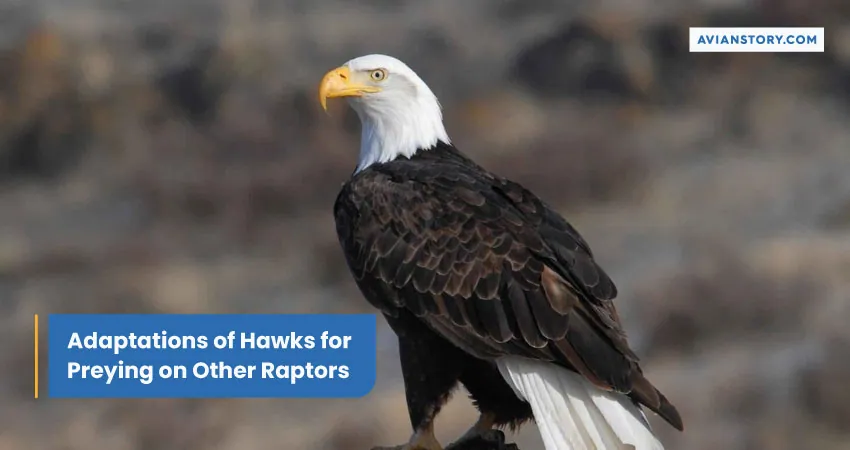
Various physical and behavioral adaptations enable hawks to prey on other raptors. They include
A. Physical adaptations
The physical adaptations include:
1. Talons: The sharp and curled talons allow the hawks to catch and firmly grip smaller raptors. They also use them to squeeze and choke these prey birds to kill them faster.
2. Beak: Hawks possess curved beaks with sharp tips used to tear flesh and eat prey animals. They also use them to remove feathers off these other smaller birds of prey.
3. Vision: The hawks’ great vision allows them to spot prey birds, especially young birds, in a nest a distance away. This site allows them to swoop in when the parent birds leave the nest and catch their young ones.
4. Flight agility: Hawks are more agile than most raptors, which makes them better hunters. The agility allows them to chase and catch the slower and less agile raptor species and eat them.
B. Behavioral adaptations
Hawks’ behavioral adaptations include the following.
1. Surprise attacks: The better vision and agility allow hawks to surprise attack other raptors they can prey on. This type of attack gives prey animals little to no time to escape.
2. Persistence and determination: Hawks are persistent and determined when hunting. They can perch for a long time, waiting for a chance to pounce on their prey. They are also persistent when chasing, which wears their prey animals and eats them.
3. Cooperative hunting: Some hawk species cooperate while hunting, especially a couple. Cooperative hunting allows them to wear out prey animals faster by taking turns chasing them. Also, they can overwhelm larger animals by attacking them together.
When a red-tailed hawk attacks an eagle, they usually do it as a couple. This deprives the eagle a chance to counter-attack and they successfully drive it off.
Instances of Hawks Preying on Other Raptors
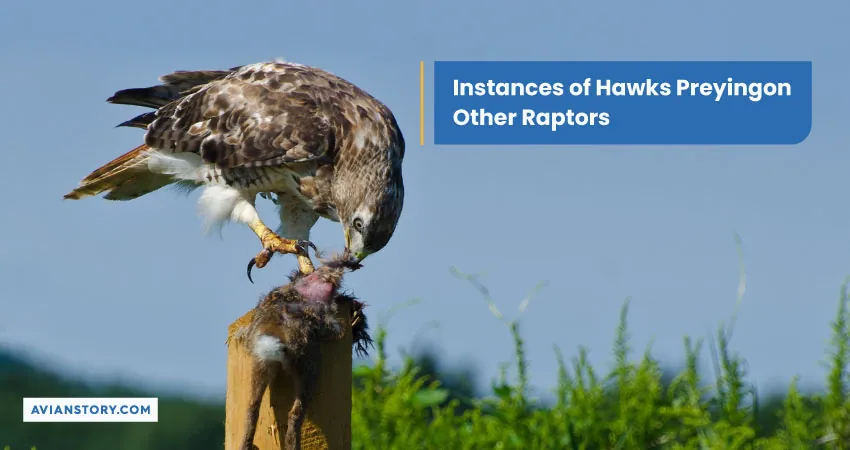
Some hawk species can prey on other raptors. Some of these hawk species capable of preying on other raptors include:
1. Goshawk: Goshawks are agile hunters, especially in forest areas, allowing them to prey on other raptors successfully.
2. Cooper’s Hawk: Cooper’s hawks are also swift flyers and catch their prey with their feet. They use their talons to squeeze the prey bird until it dies and may even drown it in water.
3. Sharp-shinned Hawk: Sharp-shinned hawks hunt by surprising their prey. The surprise attack gives them an advantage over smaller raptors.
Target raptor species
Some of the raptor species preyed on by hawks include
1. Smaller hawk species: Smaller hawk species, like the sharp-shinned and American kestrel, are among the prey animals to Coopers’ hawks and goshawks.
2. Owls: Hawks prey on owl eggs, owlets, and injured owls. They are less likely to hunt adult owls actively but may kill and eat one during a territorial fight.
3. Falcons: Some hawk species are bigger than falcons, which makes it easier to hunt them. However, like most raptors, they only hunt the sick and injured ones. Falcons often get affected by Herpesviral body disease, which they get from pigeon herpesvirus.
Impact of Hawks Preying on Eagles
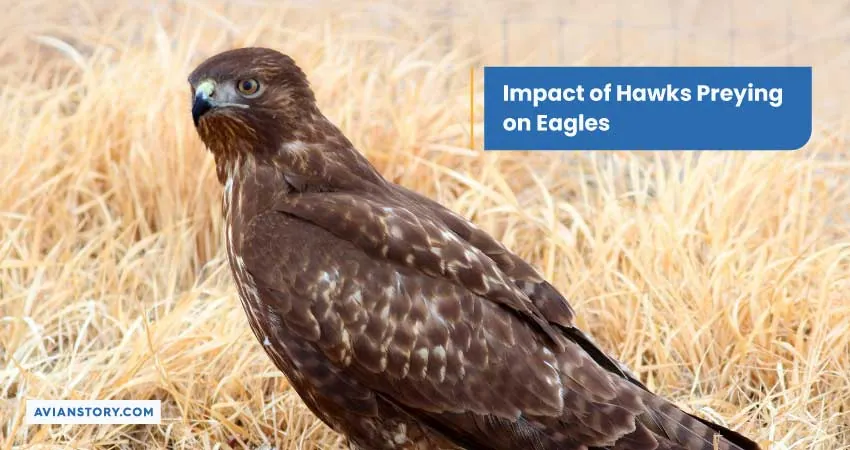
Hawks preying on eagles has various impacts. They include:
- Population dynamics: Hawks preying on eagles impacts the eagle’s population dynamics. The eagle population may decrease over time in this area until the predation stops or decreases.
- Predator-prey relationship: With the predators preying on each other, the prey population is unaffected and continues to increase. This predation affects the predator-prey relationship between the hawks and their usual prey animals.
- Influence on prey species: The eagle species serving as prey are influenced significantly mostly as their numbers decrease. However, as mentioned above, the prey animals continue to grow.
Human Impact on Hawk-Eagle Interactions
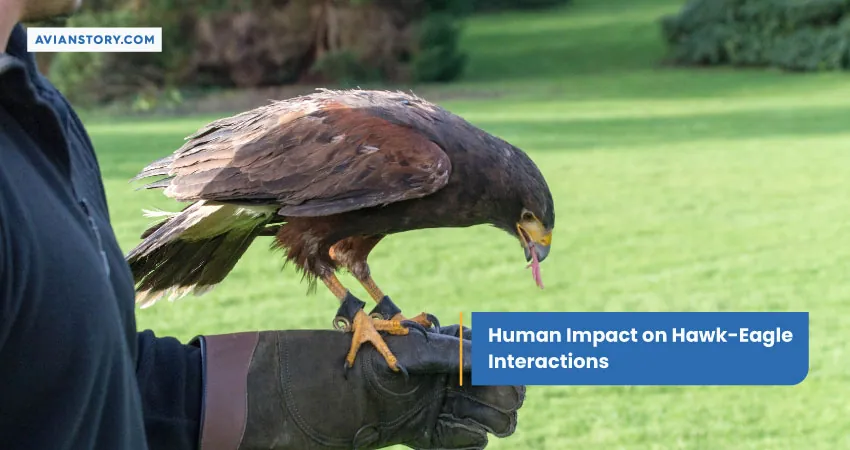
Humans impact hawk-eagle interactions in various ways. They include:
- Habitat loss and fragmentation: Through habitat loss or fragmentation, hawks and eagles lose their native habitats. They are forced to scramble in the few available habitats, increasing instances of them fighting and preying on each other.
- Pollution and pesticides: Pesticides, mostly those with agents like azinphos-methyl and pollution, affect these birds of prey’s health by eating an affected animal. Since they’re opportunistic feeders, most die through eating these affected animals.
- Climate change: Climate change has also forced most eagles and hawks from their preferred habitats. In the new habitats, the birds are forced to live near each other, where they often fight.
Conservation Efforts and Implications
Various efforts and implications can help in preventing hawk-eagle interactions. They include
The protection of nesting areas
Through protecting the nesting areas, the birds are not forced to move from these habitats to urban centers and other locations. Also, protecting nesting areas decreases the possibility of nest attacks from other predators.
Habitat restoration and preservation
In places where the native hawk and eagle habitats have been destroyed, restoration efforts can help by reducing their numbers in one area. Preservation can help prevent hawk and eagle congestion in one place.
Education and awareness campaigns
Education and awareness campaigns on hawk-eagle interaction can help reduce their interactions. With this knowledge, people can be more against damaging activities like deforestation.
Last Words
Hawks and eagles can eat a variety of foods and, in some instances, feed on the young or eggs of each other. Nonetheless, it’s unlikely for a hawk to hunt adult eagles as they are larger than them. However, the two birds regularly engage in aerial battles.
Hawks prey on other raptors, like owls and falcons, as they’re opportunistic hunters. They often eat the sick and the young of these birds but rarely the adults. Humans contribute to hawk-eagle interactions through habitat fragmentation and pollution.
Resources:
- https://pubchem.ncbi.nlm.nih.gov/compound/Azinphos-methyl#section=Deprecated-CAS
- https://pubmed.ncbi.nlm.nih.gov/18436674/#:~:text=Herpesviral%20inclusion%20body%20disease%20in,pigeon%20herpesvirus%20(columbid%20herpesvirus%201)
